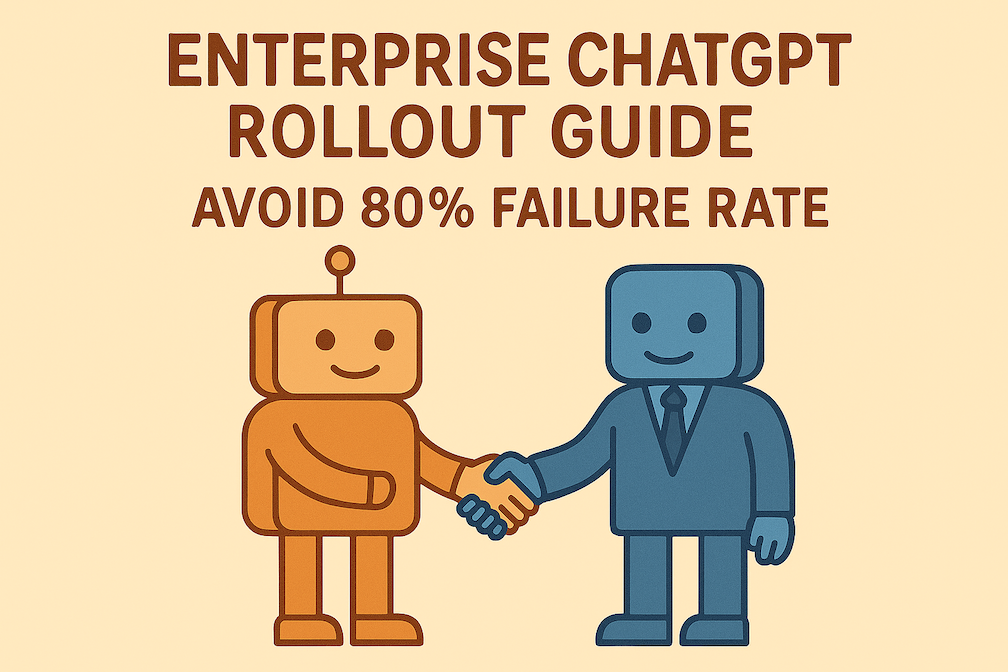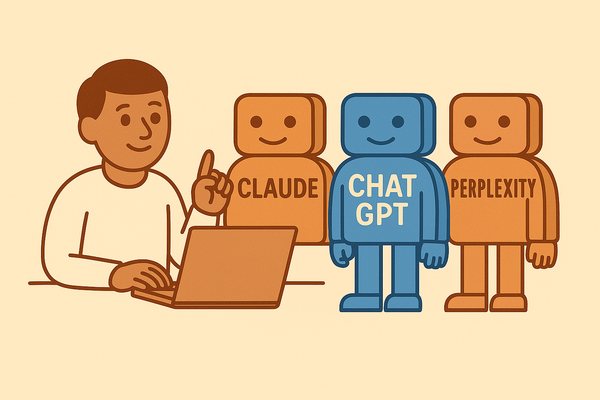Why 80% of Enterprise AI Rollouts Fail (And What the Successful 20% Actually Do)

Based on case studies from Pennsylvania, PwC, BBVA, and other organizations achieving measurable results.
Table of Contents
- The Implementation Reality
- Why Enterprise ChatGPT Is Different
- What Successful Organizations Actually Do
- What Successful Organizations Do Differently
- Your Next Steps
The Implementation Reality
Right now, while you're reading this, 4 out of 5 enterprise AI projects are failing. 70-85% of AI projects fail to meet their desired ROI, with 42% of companies abandoning most AI initiatives in 2024 (up from 17% in 2023).
But here's what should give you hope: Pennsylvania state government just proved there's a better way, delivering 95 minutes of daily time savings per user, with 85% of pilot participants reporting positive experiences.
The difference? Successful organizations treat ChatGPT Enterprise implementation as organizational transformation, not just software installation.
You've decided ChatGPT Enterprise makes sense for your organization. Now comes the critical question: how do you implement it without joining the failure statistics?
After diving deep into successful enterprise deployments from Pennsylvania state government, PwC, BBVA, and others, I've synthesized the proven methodologies that separate the 20% who succeed from the 80% who fail. After analyzing these case studies, it looks like the most successful organizations approach implementation in four distinct phases.
What you'll get: The specific approach used by successful organizations, timelines for each phase, policy templates you can use immediately, and the exact success metrics that matter.
Why Enterprise ChatGPT Is Different (And Why It Matters)
Before you dive into implementation, you need to understand what makes ChatGPT Enterprise fundamentally different from the consumer version your employees might already use.
Unlimited GPT-4o Access You get uncapped requests to GPT-4o at roughly 2× the throughput of standard GPT-4, eliminating the usage throttles that create workflow bottlenecks. No more "you've hit your limit" messages during critical work sessions.
128k Context Window The underlying GPT-4o engine for Enterprise supports a 128k-token context length, four times Plus and Team. That means approximately 200 pages of text or large codebases can be reasoned over without external chunking. Your employee handbook, entire policy documents, and comprehensive reports can be analyzed as complete units.
Enterprise Security All your inputs and outputs remain your property and are never used to further train OpenAI models, with AES-256 encryption at rest and TLS 1.2+ in transit. Don't worry about exactly what this means, but know that it's important. It's contractually backed and reinforced by SOC 2 Type 2 compliance.
Deep System Integration Built-in connectors for SharePoint, Google Drive, Box, Outlook, Slack, and GitHub let the model read live files under your existing user permissions. This transforms ChatGPT from an isolated tool into an integrated part of your tech stack.
"95 minutes of daily time savings per user isn't just productivity improvement—it's competitive advantage."
These technical differences matter because they enable enterprise-grade workflows that simply aren't possible with consumer versions. Understanding this foundation is crucial for your successful implementation.
What Successful Organizations Actually Do
Based on successful deployments from organizations like Pennsylvania state government, PwC (100,000 employees), and BBVA (3,000 licenses with 80% of users saving 2+ hours weekly), the most successful implementations follow a consistent pattern across four phases:
Phase 1: Build Your Foundation (Months 1-2)
Set Up Your Governance Framework Start with comprehensive AI policies before any deployment. Organizations that succeed have clear guidelines covering data usage, acceptable use cases, and security protocols.
FRSecure provides enterprise AI policy templates covering customer data confidentiality, chat log retention, and violation consequences. Kairoi offers open-source policy templates with CC-BY 4.0 licensing for free organizational adaptation.
Configure Technical Security Set up SAML SSO, SCIM provisioning, and role-based access controls before any user access. This foundation enables safe scaling as you expand your implementation.
Form Your Cross-Functional AI Council Create a governance body including IT, Legal, HR, Security, and key business units. McKinsey's research emphasizes moving from scattered initiatives to strategic programs with cross-functional squads.
Phase 2: Your 90-Day Pilot That Proves ROI (Months 2-3)
Follow Pennsylvania's Proven Model Pennsylvania launched their pilot with 50-100 employees across departments, focusing on practical use cases: email drafting, document summarization, and policy research.
You should start your pilot the same way:
Your Success Factors:
- Run biweekly feedback sessions and live demonstrations
- Maintain human oversight requirements throughout
- Document time savings measurement (targeting Pennsylvania's 95 minutes daily)
Your Pilot Structure:
- Week 1-2: Select participants and conduct initial training
- Week 3-8: Active usage with intensive monitoring
- Week 9-12: Analyze results and refine processes
The pilot phase isn't about proving ChatGPT works. It's about proving your implementation methodology works within your specific organizational context.
Phase 3: Department Scale (Months 4-6)
PwC's Systematic Expansion PwC's approach to rolling out ChatGPT Enterprise to 100,000 employees demonstrates systematic department-by-department scaling rather than company-wide deployment.
Department Prioritization Strategy:
- High-Impact Areas: HR for policy documentation, IT for code assistance, Legal for document analysis
- Early Adopter Departments: Groups with pilot participants showing enthusiasm
- Strategic Business Units: Revenue-generating departments with clear ROI potential
Training Framework Implementation:
- Role-specific modules for different job functions
- Technical training on Enterprise features and security protocols
- Policy training covering governance requirements and compliance
- Hands-on practice with real business scenarios
Phase 4: Enterprise Integration (Months 6-12)
BBVA's Custom GPT Approach BBVA's deployment resulted in employees creating over 2,900 custom GPTs for specific functions across legal, marketing, and finance departments. This demonstrates the power of allowing departmental customization within governed frameworks.
Advanced Implementation Features:
- Deploy connectors for SharePoint, Google Drive, GitHub, and other business systems
- Enable Advanced Data Analysis for spreadsheet and data processing workflows
- Develop custom connectors using Model Context Protocol for proprietary systems
- Create department-specific custom GPTs for specialized workflows
Integration Success Metrics:
- Usage analytics showing consistent adoption across departments
- Custom GPT creation indicating deep workflow integration
- Measurable productivity improvements (targeting the 2+ hours weekly BBVA achieved)
- Zero security incidents during scaled deployment
Implementation Realities: What Successful Organizations Do Differently
After analyzing successful deployments, several patterns emerge that differentiate organizations achieving measurable value:
They Treat It as Change Management, Not Technology Deployment Research shows 63% of organizations cite human factors as the primary AI implementation challenge, with 38% reporting insufficient training in AI tools.
Here's what you should invest in for successful change management:
- Clear communication about job enhancement rather than replacement
- Comprehensive training programs addressing both technical and policy aspects
- Champion networks providing peer-to-peer support and real-world demonstrations
- Continuous feedback collection and process refinement
They Plan for 12-18 Month Value Realization McKinsey's research indicates you need patient, strategic implementation rather than rushed deployment. Organizations expecting immediate transformation typically join the failure statistics.
Your realistic timeline expectations:
- Months 1-3: Foundation building and pilot validation
- Months 4-6: Department-level scaling and training
- Months 7-12: Enterprise integration and workflow optimization
- Months 12-18: Full value realization and competitive advantage development
They Measure Business Impact, Not Usage Statistics Instead of tracking logins and session counts, you should focus on:
- Time savings per user (Pennsylvania's 95 minutes daily provides your benchmark)
- Process efficiency improvements (BBVA's 2+ hours weekly savings shows what's possible)
- Quality improvements and error reduction
- Employee satisfaction and engagement metrics
"While 80% of organizations are failing, the 20% who succeed are capturing transformational competitive advantage."
Your Next Steps: Implementation Roadmap
If you're ready to build ChatGPT Enterprise implementation that joins the successful 20%, here's your immediate action plan:
This Week:
- Download and customize AI policy templates (FRSecure and Kairoi provide your starting points)
- Form your cross-functional AI Council with representatives from IT, Legal, HR, and Security
- Assess your current SSO and access control infrastructure for ChatGPT Enterprise requirements
Next 30 Days:
- Define your pilot group (50-100 employees from diverse departments)
- Establish baseline productivity measurements for your pilot participants
- Configure ChatGPT Enterprise security settings and user provisioning
- Develop role-specific training curricula based on your pilot use cases
Months 2-3:
- Launch your controlled pilot with intensive monitoring and feedback collection
- Document specific time savings and productivity improvements
- Refine policies and processes based on real-world usage patterns
- Plan department-level scaling strategy based on your pilot learnings
Remember: this isn't about implementing the latest AI tool. It's about building sustainable competitive advantage through systematic technology adoption that enhances human capability rather than replacing it.
What's coming next: Organizations that nail ChatGPT Enterprise implementation now will have the infrastructure and experience to rapidly adopt the next wave of AI capabilities. Those still struggling with basic rollouts in 2025 will find themselves increasingly behind as AI becomes table stakes for competitive business operations.
The technology foundation is proven. The implementation methodology is validated by organizations achieving measurable results. The question is whether you'll invest the strategic patience and systematic execution required to join Pennsylvania, PwC, and BBVA among the organizations capturing transformational value.
If you're looking for support in figuring out AI strategy for your organization, check out efora for a human-centered approach to AI implementation.
Ready to move beyond successful implementation to measuring real business impact? Understanding how to prove ROI and demonstrate value to leadership is the crucial next step in your ChatGPT Enterprise journey.




